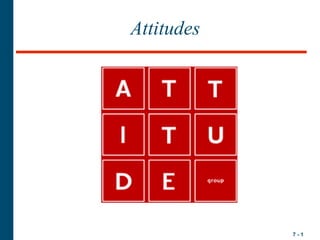
Attitude
- 1. Attitudes 7-1
- 2. The Power of Attitudes • Attitude: – A lasting, general evaluation of people (including oneself), objects, advertisements, or issues – Anything toward which one has an attitude is called an object (Ao). – Attitudes are lasting because they tend to endure over time. 7-2
- 3. The Functions of Attitudes • Functional Theory of Attitudes: Attitudes exist because they serve some function for the person (i.e., they are determined by a person’s motives) 7-3
- 4. Katz’s Attitude Functions – Katz believes there is an adjustive function of motivation. – He says people adjust attitudes to minimize harm and maximize happiness. – This serves an ego-defensive function because it helps protect one's self respect. Example: Toyota Car and Toyota Prado SUV 7-4
- 5. The ABC Model of Attitudes • Affect: – The way a consumer feels about an attitude object • Behavior: – Involves the person’s intentions to do something with regard to an attitude object • Cognition: – The beliefs a consumer has about an attitude object • Hierarchy of Effects: – A fixed sequence of steps that occur en route to an attitude 7-5
- 6. Three Hierarchies of Effects 7-6
- 7. Attitude Hierarchies • The Standard Learning Hierarchy: – Consumer approaches a product decision as a problem-solving process • The Low-Involvement Hierarchy: – Consumer does not have strong initial preference – Consumer acts on limited knowledge – Consumer forms an evaluation only after product trial • The Experiential Hierarchy: – Consumers act on the basis of their emotional reactions 7-7
- 8. Experiential Hierarchy • Emotional Contagion: – Emotions expressed by the communicator of a marketing message affect the attitude toward the product • Cognitive-Affective Model: – Argues that an affective judgment is the last step in a series of cognitive processes • Independence Hypothesis: – Takes the position that affect and cognition involve two separate, independent systems 7-8
- 9. Smith and Wollensky • This ad for New York’s famous Smith & Wollensky restaurant emphasizes that marketers and others associated with a product or service are often more involved with it than are their consumers. 7-9
- 10. Product Attitudes Don’t Tell the Whole Story • Attitude Toward the Advertisement (Aad): – A predisposition to respond in a favorable or unfavorable manner to a particular advertising stimulus during a particular exposure occasion • Ads Have Feelings Too: – Three emotional dimensions: • Pleasure, arousal, and intimidation – Specific types of feelings that can be generated by an ad • Upbeat feelings: Amused, delighted, playful • Warm feelings: Affectionate, contemplative, hopeful • Negative feelings: Critical, defiant, offended 7 - 10
- 11. Forming Attitudes • Not All Attitudes are Created Equal: – Levels of Commitment to an Attitude: The degree of commitment is related to the level of involvement with an attitude object • Compliance • Identification • Internalization – The Consistency Principle: • Principle of Cognitive Consistency: Consumers value harmony among their thoughts, feelings or behaviors to be consistent with other experiences 7 - 11
- 12. Levels of Attitudinal Commitment • By describing Cadillac as “my company,” the woman in this ad exhibits a high level of attitudinal commitment to her employer. 7 - 12
- 13. Forming Attitudes (cont.) • Cognitive Dissonance and Harmony among Attitudes: – Theory of Cognitive Dissonance: When a person is confronted with inconsistencies among attitudes or behaviors, he or she will take action to reduce the dissonance by changing an attitude or modifying a behavior. • Self-Perception Theory: – People maintain consistency by inferring that they must maintain a positive attitude toward a product they have bought or consumed • Foot-in-the-door technique: – Sales strategy based on the observation that consumers will comply with a request if they have first agreed to comply with a smaller request 7 - 13
- 14. Attitudinal Commitment • This ad for a magazine illustrates that consumers often distort information so that it fits with what they already believe or think they know. 7 - 14
- 15. Social Judgment Theory • Social Judgment Theory: – People assimilate new information about Ao’s based on what they already know or feel. – Attitudes of Acceptance and Rejection: People differ in the information they find acceptable or unacceptable. • Assimilation effect: Messages that fall within the latitude of acceptance tend to be seen as more consistent with one’s position than they actually are • Contrast effect: Messages falling within the latitude of rejection tend to be seen as being farther from one’s position than they actually are 7 - 15
- 16. Balance Theory • Triad: – An attitude structure consisting of three elements • (1) A person and his/her perceptions of • (2) an attitude object, and • (3) some other person or object • Unit relation: – An element is seen as belonging to or being part of the other • Sentiment relation: – Two elements are linked because one has expressed a preference for the other • Marketing Applications of Balance Theory – Celebrity endorsements 7 - 16
- 17. Alternative Routes to Restoring Balance in a Triad Figure 7.2 7 - 17
